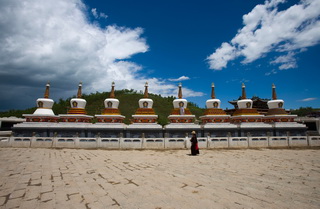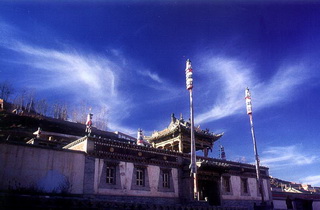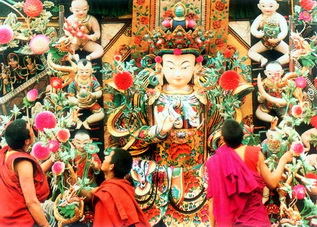 Sitting approx 27km southeast from Xining, Ta'er Si , also known as Kumbum Monastery in Tibetan, is acknowledged to be one of the six most important monasteries along with the Ganden, Sera and Drepung monasteries in Lhasa, the Tashilhunpo Monastery in Shigatse and the Labrang Monastery in Xiahe. Although not nearly as attractive as Labrang, and rather swamped by local tourists, Ta'er Si is nevertheless a good introduction for outsiders to Tibetan culture. Both as the birthplace of Tsongkhapa, the founder of the Yellow Hat Sect , and as the former home of the current Dalai Lama, the monastery attracts droves of pilgrims from Tibet, Qinghai and Mongolia, who present a startling picture with their rugged features, huge embroidered coats and chunky jewellery.
Sitting approx 27km southeast from Xining, Ta'er Si , also known as Kumbum Monastery in Tibetan, is acknowledged to be one of the six most important monasteries along with the Ganden, Sera and Drepung monasteries in Lhasa, the Tashilhunpo Monastery in Shigatse and the Labrang Monastery in Xiahe. Although not nearly as attractive as Labrang, and rather swamped by local tourists, Ta'er Si is nevertheless a good introduction for outsiders to Tibetan culture. Both as the birthplace of Tsongkhapa, the founder of the Yellow Hat Sect , and as the former home of the current Dalai Lama, the monastery attracts droves of pilgrims from Tibet, Qinghai and Mongolia, who present a startling picture with their rugged features, huge embroidered coats and chunky jewellery.  The countryside around is beautiful the views stretch away to distant mountains, and you can ramble through hills of wheat, pastures dotted with cattle or horses, and over ridges and passes strewn with wild flowers. Apart from the large numbers of Han Chinese tourists, the people you meet here are mainly Tibetan horsemen, workers in the fields who will offer an ear of roasted barley by way of hospitality, or pilgrims prostrating their way around the monastery walls.
The countryside around is beautiful the views stretch away to distant mountains, and you can ramble through hills of wheat, pastures dotted with cattle or horses, and over ridges and passes strewn with wild flowers. Apart from the large numbers of Han Chinese tourists, the people you meet here are mainly Tibetan horsemen, workers in the fields who will offer an ear of roasted barley by way of hospitality, or pilgrims prostrating their way around the monastery walls.
Kumbum Monastery was built in 1379 during the Qing Dynasty and now occupies an  area of over 400,000 square meters (99 acres). Its grounds include many temples-representing both Tibetan and Han architectural styles-scattered on both slopes of a valley of Lotus Mountain. Of all these, the largest and most famous is the Grand Gold-Tile Hall, located in the center of the monastery. It has exquisite and glittering green walls and golden tiles, and as a complex that includes other buildings, represents a unique blend of Han and Tibetan building techniques. At the center of the Grand Gold-Tile Hall, there is an 11-meter-high Grand Silver Tower where it is said that Tsongkhapa was born. What's more impressive is that all the sculptures are carved out of yak butter, which is a uniquely Tibetan art tradition that goes back 1300 years.
area of over 400,000 square meters (99 acres). Its grounds include many temples-representing both Tibetan and Han architectural styles-scattered on both slopes of a valley of Lotus Mountain. Of all these, the largest and most famous is the Grand Gold-Tile Hall, located in the center of the monastery. It has exquisite and glittering green walls and golden tiles, and as a complex that includes other buildings, represents a unique blend of Han and Tibetan building techniques. At the center of the Grand Gold-Tile Hall, there is an 11-meter-high Grand Silver Tower where it is said that Tsongkhapa was born. What's more impressive is that all the sculptures are carved out of yak butter, which is a uniquely Tibetan art tradition that goes back 1300 years.

 China Tours
China Tours Tibet Tours
Tibet Tours China Theme Tours
China Theme Tours Off The Beaten Track
Off The Beaten Track Yangtze Cruises
Yangtze Cruises China Trip Planner
China Trip Planner Travel Agents
Travel Agents China Tours
China Tours Tibet Tours
Tibet Tours China Theme Tours
China Theme Tours Off The Beaten Track
Off The Beaten Track Yangtze Cruises
Yangtze Cruises China Trip Planner
China Trip Planner Travel Agents
Travel Agents


 0086-28-85711328
0086-28-85711328 0086-28-85546015
0086-28-85546015





 Sitting approx 27km southeast from Xining, Ta'er Si , also known as Kumbum Monastery in Tibetan, is acknowledged to be one of the six most important monasteries along with the Ganden, Sera and Drepung monasteries in Lhasa, the Tashilhunpo Monastery in Shigatse and the Labrang Monastery in Xiahe. Although not nearly as attractive as Labrang, and rather swamped by local tourists, Ta'er Si is nevertheless a good introduction for outsiders to Tibetan culture. Both as the birthplace of Tsongkhapa, the founder of the Yellow Hat Sect , and as the former home of the current Dalai Lama, the monastery attracts droves of pilgrims from Tibet, Qinghai and Mongolia, who present a startling picture with their rugged features, huge embroidered coats and chunky jewellery.
Sitting approx 27km southeast from Xining, Ta'er Si , also known as Kumbum Monastery in Tibetan, is acknowledged to be one of the six most important monasteries along with the Ganden, Sera and Drepung monasteries in Lhasa, the Tashilhunpo Monastery in Shigatse and the Labrang Monastery in Xiahe. Although not nearly as attractive as Labrang, and rather swamped by local tourists, Ta'er Si is nevertheless a good introduction for outsiders to Tibetan culture. Both as the birthplace of Tsongkhapa, the founder of the Yellow Hat Sect , and as the former home of the current Dalai Lama, the monastery attracts droves of pilgrims from Tibet, Qinghai and Mongolia, who present a startling picture with their rugged features, huge embroidered coats and chunky jewellery.  The countryside around is beautiful the views stretch away to distant mountains, and you can ramble through hills of wheat, pastures dotted with cattle or horses, and over ridges and passes strewn with wild flowers. Apart from the large numbers of Han Chinese tourists, the people you meet here are mainly Tibetan horsemen, workers in the fields who will offer an ear of roasted barley by way of hospitality, or pilgrims prostrating their way around the monastery walls.
The countryside around is beautiful the views stretch away to distant mountains, and you can ramble through hills of wheat, pastures dotted with cattle or horses, and over ridges and passes strewn with wild flowers. Apart from the large numbers of Han Chinese tourists, the people you meet here are mainly Tibetan horsemen, workers in the fields who will offer an ear of roasted barley by way of hospitality, or pilgrims prostrating their way around the monastery walls.  area of over 400,000 square meters (99 acres). Its grounds include many temples-representing both Tibetan and Han architectural styles-scattered on both slopes of a valley of Lotus Mountain. Of all these, the largest and most famous is the Grand Gold-Tile Hall, located in the center of the monastery. It has exquisite and glittering green walls and golden tiles, and as a complex that includes other buildings, represents a unique blend of Han and Tibetan building techniques. At the center of the Grand Gold-Tile Hall, there is an 11-meter-high Grand Silver Tower where it is said that Tsongkhapa was born. What's more impressive is that all the sculptures are carved out of yak butter, which is a uniquely Tibetan art tradition that goes back 1300 years.
area of over 400,000 square meters (99 acres). Its grounds include many temples-representing both Tibetan and Han architectural styles-scattered on both slopes of a valley of Lotus Mountain. Of all these, the largest and most famous is the Grand Gold-Tile Hall, located in the center of the monastery. It has exquisite and glittering green walls and golden tiles, and as a complex that includes other buildings, represents a unique blend of Han and Tibetan building techniques. At the center of the Grand Gold-Tile Hall, there is an 11-meter-high Grand Silver Tower where it is said that Tsongkhapa was born. What's more impressive is that all the sculptures are carved out of yak butter, which is a uniquely Tibetan art tradition that goes back 1300 years.